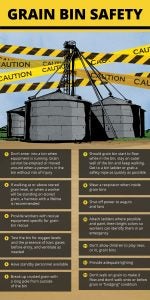More than 340 million acres of crops are experiencing extreme drought across the U.S., including most of the country’s top corn growing states. These conditions can pose major safety challenges during harvest, such as higher fire risks or lodging crops.
As agriculture professionals face circumstances out of their control, it’s important to take additional safety measures during a busy harvest season.
“Many farmers across the country are facing impacts to their yields and harvest plans as dusty, dry conditions continue to intensify,” said Brad Liggett, president of Agribusiness at Nationwide. “Proactive planning around these new hazards is important to ensure a safe harvest for you and your equipment and prevent further disruptions.”
During this dry harvest season, Nationwide’s Risk Management specialists encourage agriculture professionals to implement a few extra safety measures to help steer clear of drought-related complications.
1. Ensure fire extinguishers and water caddies are readily available: Areas experiencing drought will typically be left with very dry vegetation in and around the fields. It’s important to make sure fire extinguishers and water caddies are charged and full at the start of the day. If possible, bring extra extinguishers and always keep an eye out for any embers or small fires.
2. Scout lodging crops: Drought stricken crops may have standability issues leading to lodging or bending over at the stems near ground level, making them very difficult to harvest and reducing yield. Scout your fields carefully to identify harvest priorities and proceed through downed crops carefully.

3. Keep equipment clean: Dry crop residue can lead to extra dust and chaff. Dirty equipment can be dangerous as it leads to visibility and mechanical issues. It may be necessary to stop multiple times a day to ensure windows, reflectors, safety lights, and engine components are clean, clear, and functioning properly.
4. Turn off equipment on breaks: When you leave the combine to inspect field obstacles, plugs, or take breaks, make sure the combine is shifted into park, the head should be lowered to the ground, and the engine is shut off. Avoid leaving any equipment unattended while running — always shut off the engine.
5. Monitor crop quality: Monitor grain quality closely as harvest progresses. Keep an eye out for crops that did not reach physiological maturity, show indications of poor quality, and damage by insects or disease.
“As grain condition, temperature and moisture content greatly affect grain storability, it’s also critical to keep a close eye on grain condition as it goes into storage bins,” Liggett said. “The industry must remain vigilant about proper grain handling and storage to continue to fend off grain accidents like entrapments and engulfments.”



